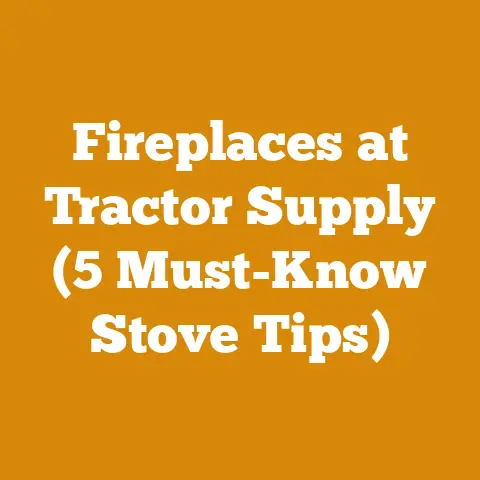Fisher Grandpa Bear Stove Smoking Too Much? (Fix Firewood Burn Issues)
Alright, let’s dive deep into the smoky mystery of the Fisher Grandpa Bear stove and how to tackle those pesky firewood burn issues. Imagine a crackling fire, the heart of your home on a chilly evening. But what if that comforting vision turns into a sooty, inefficient mess? That’s where we’re headed – towards clear skies and efficient burns.
Fisher Grandpa Bear Stove Smoking Too Much? (Fix Firewood Burn Issues)
Let’s face it, a smoking wood stove is more than just an annoyance; it’s a sign of inefficiency, wasted fuel, and potentially hazardous conditions. The Fisher Grandpa Bear is a classic, a workhorse of a stove, but even these legends can have their hiccups. The good news is that most smoking issues are fixable with a little detective work and some straightforward adjustments. I’ll guide you through troubleshooting common problems, understanding firewood quality, and optimizing your burning techniques to ensure your Grandpa Bear roars back to life, heating your home efficiently and cleanly.
Diagnosing the Smoke Signals: What’s Causing the Problem?
First, we need to put on our Sherlock Holmes hats and figure out why your stove is puffing out more smoke than Santa’s workshop. Several factors can contribute to a smoky situation.
- Insufficient Draft: The most common culprit. Draft is the force that pulls air into the stove, fuels the fire, and sends the smoke up the chimney. Without enough draft, smoke lingers and spills out.
- Wet or Unseasoned Firewood: This is a big one. Wet wood doesn’t burn efficiently. A lot of energy has to be used to boil water and let it escape as steam, meaning less heat and more smoke.
- Air Supply Issues: Your stove needs adequate airflow to burn cleanly. Obstructions or improper damper settings can choke the fire.
- Chimney Problems: Blockages, creosote buildup, or improper chimney height can all disrupt the draft and cause smoke to back up.
- Stove Issues: Cracks, leaks, or damaged components can affect the stove’s performance and lead to smoking.
- Operator Error: Incorrect loading techniques, improper damper settings, and neglect of maintenance can all contribute to smoking.
The Draft Dilemma: Ensuring a Strong Upward Pull
Draft is the engine that drives your wood stove’s performance. Think of it as the chimney’s vacuum cleaner, sucking smoke and gases upwards.
- Chimney Height: A chimney that’s too short won’t generate enough draft. Building codes typically require a chimney to extend at least 3 feet above the highest point where it passes through the roof and at least 2 feet higher than any portion of the building within 10 feet. I remember helping a friend extend his chimney a few years back. It was a bit of a weekend project, but the difference in draft was night and day. He went from a smoky mess to a roaring fire with minimal smoke.
- Chimney Diameter: The diameter of your chimney flue must match the stove’s outlet size. An undersized flue restricts airflow, while an oversized one can cool the smoke too quickly, leading to creosote buildup and poor draft.
- Chimney Location: External chimneys are more prone to cold air and can struggle to establish a draft, especially during cold starts. Internal chimneys, which run through the heated portion of the house, generally perform better.
- Chimney Condition: Creosote buildup is a major draft killer. Creosote is a tar-like substance that forms when wood smoke condenses in the chimney. It’s highly flammable and can cause chimney fires. Regular chimney inspections and cleanings are crucial. I make it a point to clean my chimney at least twice a year, once before the heating season and once midway through.
- Barometric Dampers: These dampers can help regulate draft in areas with strong winds or fluctuating pressures. They automatically adjust to maintain a consistent draft, preventing excessive draw that can waste fuel.
Cost Considerations:
- Chimney Cleaning: Professional chimney sweeps typically charge between \$150 and \$300 for a standard cleaning. DIY cleaning kits can be purchased for around \$50-\$100, but you’ll need to be comfortable working at heights and have the proper safety equipment.
- Chimney Extension: Extending a chimney can cost anywhere from \$500 to \$2,000, depending on the materials used and the complexity of the job.
- Chimney Liner Installation: Installing a new chimney liner can range from \$800 to \$3,000, depending on the type of liner and the length of the chimney.
The Firewood Factor: Dry Wood is Happy Wood
The quality of your firewood is paramount. Wet or unseasoned wood is the enemy of a clean-burning fire.
- Moisture Content: Ideally, firewood should have a moisture content of 20% or less. Freshly cut wood can have a moisture content of 50% or more.
- Seasoning Time: Seasoning is the process of drying firewood to reduce its moisture content. This typically takes 6-12 months, depending on the wood species, climate, and how the wood is stored.
- Wood Species: Hardwoods like oak, maple, and ash are denser and burn longer than softwoods like pine and fir. They also produce less smoke and creosote.
- Storage: Store firewood off the ground, in a well-ventilated area, and covered to protect it from rain and snow. I use pallets to keep my wood off the ground and stack it loosely to allow air to circulate.
- Testing Moisture Content: A moisture meter is a handy tool for checking the moisture content of your firewood. These meters are relatively inexpensive and can save you a lot of headaches.
Cost Considerations:
- Firewood Prices: The price of firewood varies depending on location, wood species, and supplier. In my area, a cord of seasoned hardwood typically costs between \$200 and \$400.
- Moisture Meter: Moisture meters can be purchased for as little as \$20 or as much as \$100, depending on the features and accuracy.
- Seasoning Time vs. Buying Seasoned Wood: Buying seasoned wood upfront is more expensive, but saves you time and space. When I was getting started, I bought seasoned wood for the first year while I seasoned my own.
Calculating Firewood Costs:
Let’s break down the cost of preparing your own firewood. Assume you want to process 5 cords of firewood per year.
- Timber Purchase (if applicable): Let’s say you can buy standing timber for \$50 per cord equivalent. Total timber cost: 5 cords * \$50/cord = \$250.
- Chainsaw: A decent chainsaw for firewood processing costs around \$300-\$500. Let’s average it to \$400.
- Chainsaw Maintenance (fuel, oil, sharpening): Approximately \$50 per cord. Total maintenance cost: 5 cords * \$50/cord = \$250.
- Splitting Maul/Axe: A good quality splitting maul costs around \$80.
- Labor (your time): This is tricky to quantify. If you value your time at \$20 per hour, and it takes you 4 hours to process a cord, your labor cost is \$80 per cord. Total labor cost: 5 cords * \$80/cord = \$400.
- Total Cost: \$250 (timber) + \$400 (chainsaw) + \$250 (chainsaw maintenance) + \$80 (splitting maul) + \$400 (labor) = \$1380.
- Cost per Cord: \$1380 / 5 cords = \$276 per cord.
This calculation gives you a rough estimate. Remember to adjust the numbers based on your specific circumstances and location.
Airflow Alchemy: Optimizing Air Supply
Your stove needs air to breathe. Proper airflow ensures complete combustion and reduces smoke.
- Damper Settings: Experiment with different damper settings to find the sweet spot where the fire burns hot and clean without wasting fuel. Start with the damper fully open when starting a fire, then gradually close it down as the fire establishes itself.
- Air Leaks: Check for air leaks around the stove door, flue collar, and other joints. Seal any leaks with high-temperature sealant.
- Ash Removal: Regularly remove ash from the firebox to ensure adequate airflow to the fire.
- Combustion Air Kits: These kits draw combustion air from outside the house, which can improve draft and reduce competition for air with other appliances.
Cost Considerations:
- High-Temperature Sealant: A tube of high-temperature sealant typically costs around \$10-\$20.
- Combustion Air Kit: Combustion air kits can range from \$50 to \$200, depending on the complexity of the installation.
Stove Savvy: Inspecting and Maintaining Your Grandpa Bear
A well-maintained stove is a happy stove. Regular inspections and maintenance can prevent smoking and ensure optimal performance.
- Door Gasket: The door gasket seals the stove door to the firebox, preventing air leaks. Inspect the gasket regularly and replace it if it’s damaged or worn.
- Baffle: The baffle is a metal plate inside the firebox that helps to direct airflow and improve combustion. Make sure the baffle is in good condition and properly positioned.
- Firebrick: Firebrick lines the firebox and protects the stove’s metal walls from the intense heat. Replace any cracked or damaged firebricks.
- Stove Pipe: Inspect the stove pipe for rust, corrosion, or damage. Replace any damaged sections.
Cost Considerations:
- Door Gasket: A new door gasket typically costs around \$20-\$40.
- Firebrick: Individual firebricks can be purchased for around \$5-\$10 each.
- Stove Pipe: A section of stove pipe can cost anywhere from \$20 to \$50, depending on the material and diameter.
Burning Best Practices: Mastering the Art of Fire
Even with the best stove and firewood, improper burning techniques can lead to smoking.
- Top-Down Burning: This method involves starting the fire from the top down, which produces less smoke and more efficient combustion. Layer large pieces of wood on the bottom, followed by smaller pieces, and then kindling on top. Light the kindling and let the fire burn downwards.
- Loading Techniques: Load wood tightly to maximize the amount of fuel in the firebox, but leave enough space for air to circulate.
- Avoid Overloading: Overloading the firebox can smother the fire and cause smoking.
- Burn Hot Fires: Hot fires burn cleaner and produce less creosote. Avoid smoldering fires, which are inefficient and generate a lot of smoke.
The Economics of Wood Burning: A Cost-Benefit Analysis
Let’s consider the overall cost of heating with wood compared to other options.
- Firewood Costs: As we discussed earlier, the cost of firewood varies depending on location and whether you buy it or process it yourself.
- Stove Costs: A new wood stove can cost anywhere from \$1,000 to \$5,000, depending on the size, features, and efficiency.
- Installation Costs: Professional installation can add another \$500 to \$2,000 to the cost of a new stove.
- Maintenance Costs: Regular maintenance, including chimney cleaning and parts replacement, can cost several hundred dollars per year.
- Comparison to Other Fuels: Compare the cost of heating with wood to the cost of heating with oil, gas, or electricity. Consider factors like fuel prices, efficiency, and maintenance costs.
Example Scenario:
Let’s say you heat your home with wood for 5 months of the year.
- Firewood Consumption: 4 cords of wood per year.
- Firewood Cost: \$300 per cord (bought seasoned). Total firewood cost: 4 cords * \$300/cord = \$1200.
- Chimney Cleaning: \$200 per year.
- Maintenance: \$100 per year.
- Total Annual Cost: \$1200 (firewood) + \$200 (chimney cleaning) + \$100 (maintenance) = \$1500.
Compare this to the cost of heating with natural gas. Let’s say your natural gas bill is \$250 per month for 5 months.
- Total Annual Cost (Natural Gas): \$250/month * 5 months = \$1250.
In this scenario, heating with wood is slightly more expensive. However, the actual cost will vary depending on your specific circumstances. And of course, burning wood can be more sustainable.
Budgeting for Firewood: A Practical Guide
Creating a budget for firewood can help you manage your costs and ensure that you have enough fuel for the heating season.
- Estimate Your Firewood Needs: Determine how much firewood you’ll need based on the size of your home, the climate, and your heating habits.
- Research Firewood Prices: Compare prices from different suppliers and consider the cost of processing your own firewood.
- Factor in Maintenance Costs: Don’t forget to budget for chimney cleaning, parts replacement, and other maintenance expenses.
- Create a Spreadsheet: Use a spreadsheet to track your firewood expenses and compare them to your budget.
Example Firewood Budget:
| Item | Estimated Cost |
|---|---|
| Firewood (4 cords) | \$1200 |
| Chimney Cleaning | \$200 |
| Maintenance | \$100 |
| Moisture Meter | \$30 |
| Chainsaw Maintenance | \$50 |
| Total | \$1580 |
Chainsaws and Splitting Tools: Investing Wisely
The tools you use to process firewood can have a significant impact on your costs and efficiency.
- Chainsaws: Choose a chainsaw that’s appropriate for the size of the wood you’ll be cutting. Consider factors like engine size, bar length, and weight.
- Splitting Tools: A splitting maul or axe is essential for splitting firewood. Consider a hydraulic log splitter if you process a lot of wood. I remember when I finally upgraded to a hydraulic splitter – it saved me so much time and energy.
- Safety Gear: Always wear appropriate safety gear, including a helmet, eye protection, hearing protection, and gloves.
Cost Considerations:
- Chainsaw: A good quality chainsaw can cost anywhere from \$300 to \$1,000 or more.
- Splitting Maul: A splitting maul typically costs around \$50-\$100.
- Hydraulic Log Splitter: A hydraulic log splitter can range from \$1,000 to \$3,000 or more.
- Safety Gear: Safety gear can cost around \$100-\$200.
Wood Species and Their Impact on Cost
Different wood species have different burning characteristics and prices.
- Hardwoods: Hardwoods like oak, maple, and ash are denser and burn longer than softwoods. They also produce less smoke and creosote.
- Softwoods: Softwoods like pine and fir are less expensive than hardwoods, but they burn faster and produce more smoke.
- Mixed Loads: Some suppliers sell mixed loads of hardwood and softwood. These loads can be a good value, but make sure you know what you’re getting.
Cost Comparison:
| Wood Species | Price per Cord (Approximate) | Burning Characteristics |
|---|---|---|
| Oak | \$350-\$450 | Dense, long-burning, low smoke |
| Maple | \$300-\$400 | Dense, long-burning, moderate smoke |
| Ash | \$250-\$350 | Dense, easy to split, moderate smoke |
| Pine | \$150-\$250 | Less dense, fast-burning, high smoke, high creosote |
| Fir | \$200-\$300 | Moderately dense, moderate burning, moderate smoke, moderate creosote |
Sustainability and Ethical Sourcing of Firewood
Consider the environmental impact of your firewood choices.
- Sustainable Harvesting: Choose firewood from sustainably managed forests.
- Local Sourcing: Buy firewood from local suppliers to reduce transportation costs and emissions.
- Avoid Invasive Species: Don’t transport firewood long distances, as this can spread invasive species.
Case Studies: Real-World Firewood Projects
Let’s look at a couple of case studies to illustrate the cost and challenges of firewood preparation.
Case Study 1: Small-Scale Firewood Processor
- Goal: To process 10 cords of firewood per year for personal use and to sell locally.
- Equipment: Chainsaw, splitting maul, pickup truck.
- Costs:
- Timber purchase: \$500
- Chainsaw maintenance: \$500
- Fuel: \$200
- Truck maintenance: \$100
- Total: \$1300
- Revenue:
- 5 cords sold at \$300/cord: \$1500
- Profit: \$200
Case Study 2: Large-Scale Firewood Supplier
- Goal: To produce and sell 100 cords of firewood per year.
- Equipment: Chainsaw, hydraulic log splitter, firewood processor, dump truck.
- Costs:
- Timber purchase: \$5000
- Equipment maintenance: \$2000
- Fuel: \$1000
- Labor: \$5000
- Transportation: \$1000
- Total: \$14000
- Revenue:
- 100 cords sold at \$300/cord: \$30000
- Profit: \$16000
Formulas and Calculations for Firewood
Here are some useful formulas for calculating firewood volume and moisture content.
- Cord Volume: A cord is a stack of wood that measures 4 feet high, 4 feet wide, and 8 feet long. The volume of a cord is 128 cubic feet.
- Board Feet: Board feet are a unit of measurement for lumber. One board foot is equal to a piece of wood that is 1 inch thick, 12 inches wide, and 12 inches long.
-
Moisture Content: Moisture content is the percentage of water in wood. It is calculated as follows:
- Moisture Content = ((Wet Weight – Dry Weight) / Dry Weight) * 100
Global and Regional Timber Prices
Timber prices vary widely depending on location, species, and quality.
- North America: Timber prices in North America have been relatively stable in recent years, but they can fluctuate depending on market conditions.
- Europe: Timber prices in Europe are generally higher than in North America, due to higher demand and stricter environmental regulations.
- Asia: Timber prices in Asia are highly variable, depending on the region and species.
Industry Benchmarks and Statistical Data
Here are some industry benchmarks and statistical data related to firewood and wood processing.
- Average Price per Cord of Firewood: The average price per cord of firewood in the United States is around \$250-\$400.
- Average Firewood Consumption per Household: The average household that heats with wood consumes around 4-6 cords of firewood per year.
- Market Size for Firewood: The market size for firewood in the United States is estimated to be around \$3 billion per year.
Actionable Takeaways and Next Steps
So, what are the key takeaways from all of this, and what should you do next if your Fisher Grandpa Bear is smoking?
- Check Your Draft: Ensure your chimney is clean, the right height, and properly sized.
- Season Your Firewood: Make sure your firewood is properly seasoned with a moisture content of 20% or less.
- Optimize Airflow: Adjust damper settings and check for air leaks.
- Maintain Your Stove: Regularly inspect and maintain your stove.
- Burn Clean Fires: Use proper burning techniques, such as top-down burning, and avoid overloading the firebox.
- Budget Wisely: Create a budget for firewood and consider the costs of equipment and maintenance.
Next Steps:
- Inspect your chimney: Schedule a professional inspection or do it yourself if you’re comfortable and have the right equipment.
- Test your firewood: Use a moisture meter to check the moisture content of your firewood.
- Adjust your burning techniques: Experiment with different damper settings and loading techniques.
- Consult a professional: If you’re still having problems, consult a qualified wood stove technician.
With a little effort and attention to detail, you can get your Fisher Grandpa Bear roaring back to life, heating your home efficiently and cleanly. Remember, a well-maintained stove and properly seasoned firewood are the keys to a smoke-free and enjoyable wood-burning experience.






